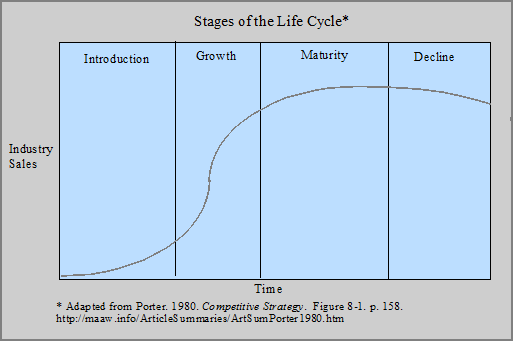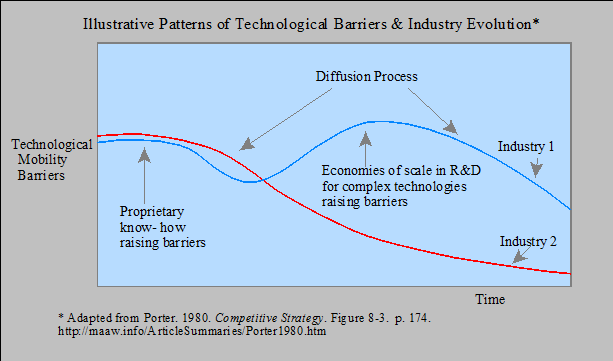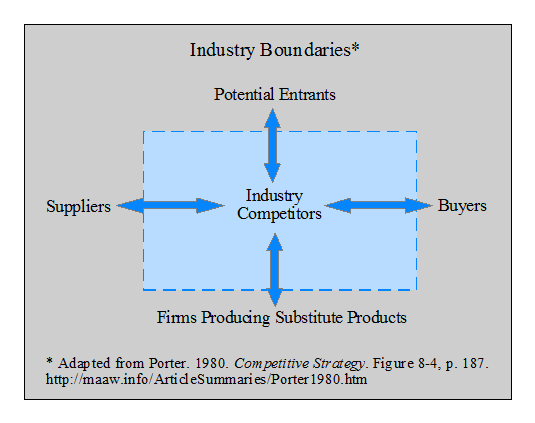
Chapter 8: Industry Evolution
Study Guide by James R. Martin, Ph.D., CMA
Professor Emeritus, University of South Florida
Porter's Competitive Strategy Main Page
Chapter 8: Industry Evolution p. 156
The purpose of this chapter is to provide some analytical tools for predicting the evolutionary process in an industry and how to use it for the development of competitive strategy. Porter describes some basic concepts related to evolution, identifies the driving forces of industry change, and discusses some related economic relationships and their strategic implications.
Basic Concepts in Industry Evolution p. 157
A simple approach to analyzing industry evolution is to begin by asking the question, are there any changes occurring in the industry that will affect any of the five competitive forces described in Chapter 1? Answering this question is difficult and requires some analytical techniques.
Product Life Cycle p. 157
A basic concept in the area of industry evolution is the life cycle. The life cycle concept illustrated in the graphic below has been applied to both products and industries. The typical S-shaped curve shows how an industry goes through the various stages from introduction to growth, to maturity, and finally decline.

However, there are criticisms of the life cycle concept that include:
The duration of the various stages varies from industry to industry,
Sometimes industries skip some stages, e.g. go from growth to decline.
Companies can affect the growth stage through innovation and repositioning, and
Competition in the various stages is different in different industries.
Since industry evolution takes so many different paths, the typical life cycle pattern is not reliable. With this fact in mind Porter includes an illustration (Figure 8-2) showing what is predicted to happen over the various stages of the life cycle related to: Buyers and buyer behavior, products and product change, marketing, manufacturing and distribution, foreign trade, overall strategy, competition, risk, margins and profits. For example, buyers must be convinced to try the product in the introduction stage, the buyer group is predicted to widen in the growth stage, and become a mass market in the maturity stage. In the area of margins and profits, there are low profits predicted in the introduction stage, high profits in the growth stage, and lower profits again in the maturity and decline stages.
A Framework for Forecasting Evolution p. 162
Industries evolve because of evolutionary processes, i.e., forces that create incentives and pressures to change. Therefore, a more useful way to examine industry evolution (than attempting to describe it) is to examine the processes that drive changes in an industry. Industries begin with an initial structure, and then evolutionary processes drive them towards their potential structure.
Evolutionary Processes p. 163
Porter describes fourteen evolutionary processes as follows:
1. Long-Run Changes in Growth p. 164
There are five reasons long-run growth in an industry changes:
Demographics - group income levels, educational levels, geographic location, population growth, age group demographics etc. For example, the U.S. birthrates affect a wide variety of products.
Trends in Needs - Changes in consumer tastes, lifestyles, social conditions, and government regulation drive changes in the demand for many products.
Changes in the Relative Position of Substitutes - Changes related to the cost and quality of substitute products affect the demand for a product, e.g., television decreased the demand for other type of entertainment.
Changes in the position of Complementary Products - Complementary products defined broadly include any product, resource or service that supports the industry's product, e.g., credit supports durable goods purchases.
Penetration of the Customer Group - An industry will eventually reach penetration where sales are primarily made to repeat buyers. The growth rate after penetration will mainly depend on the average time before the product needs to be replaced.
Product innovation can improve an industry's growth rate by offsetting some of the affects on industry growth mentioned above, e.g., innovations in the design of bicycles.
2. Changes in Buyer Segments Served p. 169
New buyer segments can be created, or additional segmentation of existing buyer segments can occur when firms create new products or develop new marketing techniques. These new segments affect industry structure in many ways, e.g., economies of scale, capital requirements etc. For this reason, an analysis of industry evolution should include buyer segments and how they affect industry structure.
3. Learning by Buyers p. 170
The accumulation of knowledge about a product tends to reduce product differentiation over time as buyers learn and require more in terms of the product's features, warranty protection, and related service. Changes in the product can offset this tendency to a certain extent by expanding the customer base and extending the benefits of product differentiation.
4. Reduction of Uncertainty p. 171
Uncertainty about the future of an industry (e.g., its potential size, optimal product configuration, potential buyers) provides some protection for early entrants, but this is reduced over time as questions about the industry are resolved. As the risk of entry into the industry is reduced, new types of entrants will emerge and successful strategies will be imitated.
5. Diffusion of Proprietary Knowledge p. 172
In the absence of patent protection, proprietary protection will erode for a number of reasons: Competitors learn from the physical inspection of proprietary products, proprietary information is embedded in the inputs of outside suppliers, personnel who leave the firm provide proprietary information to other firms or start spin-off firms, and specialized personnel become more numerous from consulting firms, university technical programs and other sources. Offsets to the diffusion of proprietary knowledge include: patent protection and the continual creation of new proprietary technology. Two of many possible situation are illustrated in the graphic below. Proprietary technology provided initial mobility barriers in both industries, but it was soon eroded by diffusion. In industry 1, economies of scale in research and development lead to a rise in mobility barriers from proprietary technology that would probably lead to a profitable maturity phase. In industry 2, mobility barriers quickly declined to a low level and a profitable maturity phase would depend on other barriers to entry.

6. Accumulation of Experience p. 174
The learning or experience curve can be a major factor for industry competition and change when firms can establish significant and sustainable advantages over competitors, particularly when experience can be kept proprietary. Firms that are left behind must either use a rapid imitation strategy, or adopt a differentiation or focus strategy.
7. Expansion (or Contraction) in Scale p. 175
Growth in an industry tends to increase the strategies available (e.g., where firms are able to adopt manufacturing and distribution methods related to economies of scale, and use vertical integration), and also tends to attract new entrants who have waited for the industry to reach a significant size to justify the cost of entry.
8. Changes in Input Costs and Exchange Rates p. 176
Changes in the cost or quality of an industry's inputs can cause changes in the structure of the industry. Industry inputs include wage rates, material costs, the cost of capital, communication costs, and transportation costs. For example, increases in labor costs tends to promote the substitution of capital for labor (automation). Exchange rate fluctuations can also create shifts in an industry's structure.
9. Product Innovation p. 177
Product innovations can affect an industry in many ways including: widening the market, nullifying buyer experience, and creating the need for new marketing, distribution, and manufacturing techniques that change mobility barriers in the industry.
10. Marketing Innovation p. 178
Innovations in marketing and distribution can affect industry structure by expanding the product to new customer groups, reducing product price sensitivity, changing the balance between fixed and variable costs, and increasing mobility barriers.
11. Process Innovation p. 178
Changes in manufacturing processes or methods can increase or decrease economies of scale, extend the experience curve, change the balance between fixed and variable costs, affect vertical integration, and affect industry structure in other ways. These changes can also be initiated by customers or suppliers, or come from outside of the industry.
12. Structural Change in Adjacent Industries p. 180
Changes in the structure of suppliers' and customers' industries can have important affects on the evolution of an industry. Porter provides an example of the chain store development in retailing during the 1960s and 1970s that caused manufacturing, marketing, and distribution strategies to adjust to the new mass merchandising revolution.
13. Government Policy Change p. 181
Government policy changes that affect industry structure include licensing requirements, pricing regulations, tariffs, product quality and safety regulations, and environmental relations. Although some of these changes provide social benefits, they all increase the costs of doing business in various ways and raise barriers facing new firms in the industry.
14. Entry and Exit p. 182
Entry into an industry, particularly by established firms from other markets can drive structural change. These new entrants have no ties to historical strategies and may be in a better position to apply technology not available to current firms in the industry. The U.S. wine industry in the 1960s provides an example. Large consumer marketing companies entered the wine industry that had previously been dominated by small family firms selling in regional markets. This caused significant structural change in the industry.
Exit barriers (e.g., requirement for specialized assets, high fixed costs to exit, strategic interrelationships, emotional barriers and government and social restrictions) may increase the dominance of the leading firms, worsen the position of the remaining firms and lead to competitive warfare.
Each evolutionary process raises a key question about the future of the industry, and identifies a number of key strategic signals, or red lights that the firm must continuously look for in the environment. These signals should generate an analysis to predict the affect of the changes for the industry along with the appropriate response. Firms must also be on the lookout for hidden changes that may be resulting with no apparent signals.
Key Relationships in Industry Evolution p. 184
Industries are interrelated systems that change in many different ways. A change in one element of an industry tends to be followed by changes in many other elements of the industry. The point is that industries are always changing in a variety of ways and there is no single model of industry evolution. Therefore, the idea of using the product life cycle as the single model of industry evolution should be rejected.
Will the Industry Consolidate? p. 185
Whether consolidation will occur in an industry depends on the interrelationships between the elements of the industry structure. If industry mobility barriers (e.g., high advertising, national distribution, brand identification) are high, concentration in an industry usually increases. Where mobility barriers are low or decreasing, firms that exit are replaced by new firms and consolidation will not occur. Exit barriers may also prevent consolidation and tend to hold firms in the industry even when they are not obtaining an adequate return on investment.
Changes in Industry Boundaries p. 186
Industry evolution tends to change industry boundaries (represented by the dotted line in the illustration below). Industry boundaries may be enlarged in many ways, e.g., by new entrants, substitute products, structural changes that make it easier for suppliers to integrate forwards, or buyers to integrate backwards.

Firms can Influence Industry Structure p. 187
Structural changes in an industry can be influenced by firms that understand how these changes will affect their competitive position. Therefore, the point of this last section is that firms should view industry change as an opportunity for improvement.
__________________________________________________
Go to the next Chapter. Porter. 1980. Competitive Strategy. Part II. Chapter 9: Competitive Strategy in Fragmented Industries. (Summary), or back to Porter's Competitive Strategy Summaries Main Page.
Summaries related to the product life cycle:
Hayes, R. H. and S. C. Wheelwright. 1979. Link manufacturing process and product life cycles. Harvard Business Review (January-February): 133-140. (Summary).
Hayes, R. H. and S. C. Wheelwright. 1979. The dynamics of process-product life cycles. Harvard Business Review (March-April): 127-136. (Summary).
Martin, J. R. Not dated. Product life cycle management. Management And Accounting Web. PLCSummary.htm
Other related summaries:
Christensen, C. M. 1997. Making strategy: Learning by doing. Harvard Business Review (November-December): 141-142, 144, 146, 148, 150-154, 156. (Summary).
Clinton, B. D. and A. H. Graves. 1999. Product value analysis: Strategic analysis over the entire product life cycle. Journal of Cost Management (May/June): 22-29. (Summary).
De Geus, A. 1999. The living company. Harvard Business Review (March-April): 51-59. (Summary).
Fonvielle, W. and L. P. Carr. 2001. Gaining strategic alignment: Making scorecards work. Management Accounting Quarterly (Fall): 4-14. (Summary).
Gosselin, M. 1997. The effect of strategy and organizational structure on the adoption and implementation of activity-based costing. Accounting, Organizations and Society 22(2): 105-122. (Summary).
Iansiti, M. and R. Levien. 2004. Strategy as ecology. Harvard Business Review (March): 68-78. (Summary).
Kaplan, R. S. and D. P. Norton. 1996. Using the balanced scorecard as a strategic management system. Harvard Business Review (January-February): 75-85. (Summary).
Kaplan, R. S. and D. P. Norton. 2000. Having trouble with your strategy? Then map it. Harvard Business Review (September-October): 167-176. (Summary).
Kaplan, R. S. and D. P. Norton. 2001. Transforming the balanced scorecard from performance measurement to strategic management: Part I. Accounting Horizons (March): 87-104. (Summary).
Kaplan, R. S. and D. P. Norton. 2001. Transforming the balanced scorecard from performance measurement to strategic management: Part II. Accounting Horizons (June): 147-160. (Summary).
Kaplan, R. S. and D. P. Norton. 2004. Measuring the strategic readiness of intangible assets. Harvard Business Review (February): 52-63. (Summary).
Kim, W. C. and R. Mauborgne. 1997. Value innovation: The strategic logic of high growth. Harvard Business Review (January-February): 103-112. (Summary).
Kim, W. C. and R. Mauborgne. 1999. Creating new market space: A systematic approach to value innovation can help companies break free from the competitive pack. Harvard Business Review (January-February): 83-93. (Summary).
Kim, W. C. and R. Mauborgne. 2002. Charting your company's future. Harvard Business Review (June): 77-83. (Summary).
Langfield-Smith, K. 1997. Management control systems and strategy: A critical review. Accounting, Organizations and Society 22(2): 207-232. (Summary).
Luehrman, T. A. 1998. Strategy as a portfolio of real options. Harvard Business Review (September-October): 89-99. (Summary).
Malone, D. and M. Mouritsen. 2014. Change management: Risk, transition, and strategy. Cost Management (May/June): 6-13. (Summary).
Martin, J. R. Not dated. What is a learning curve? Management And Accounting Web. LearningCurveSummary.htm
O'Clock, P. and K. Devine. 2003. The role of strategy and culture in the performance evaluation of international strategic business units. Management Accounting Quarterly (Winter): 18-26. (Summary).
O'Reilly, C. A. III. and M. L. Tushman. 2004. The ambidextrous organization. Harvard Business Review (April): 74-81. (Summary).
Porter, M. E. 1996. What is a strategy? Harvard Business Review (November-December): 61-78. (Summary).
Porter, M. E. 2001. Strategy and the internet. Harvard Business Review (March): 63-78. (Summary).
Reeves, M., C. Love and P. Tillmanns. 2012. Your strategy needs a strategy. Harvard Business Review (September): 76-83. (Note).
Simons, R. 1995. Control in an age of empowerment. Harvard Business Review (March-April): 80-88. (Summary).